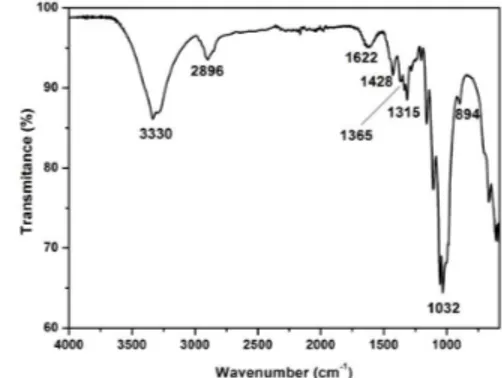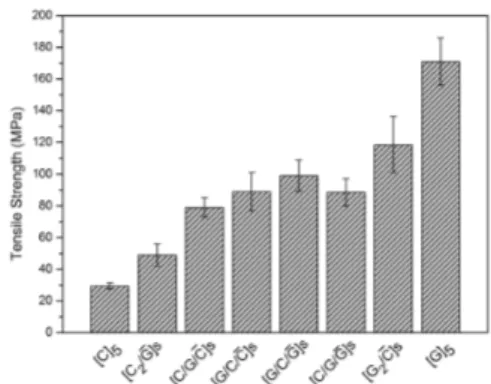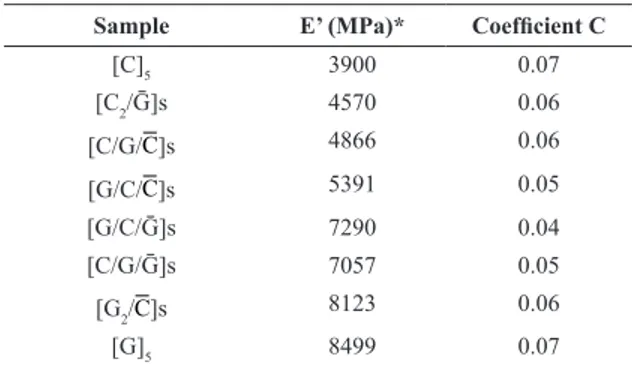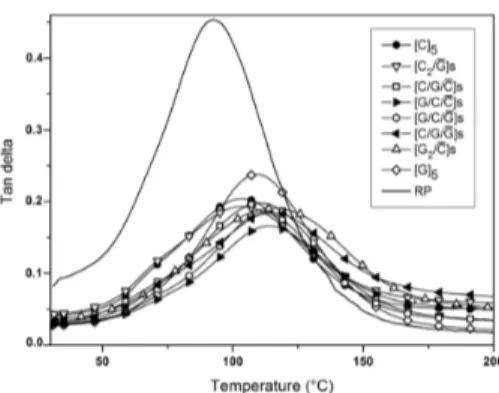*e-mail: dairomanzini@ibest.com.br
1. Introduction
Composite materials, especially those with a polymeric matrix, are of considerable interest to researchers and engineers due to a wide range of combinations in material properties 1. In particular, the use of natural ibers, such as sisal, jute,
curaua, ramie and cotton, in polymer composites has grown in recent years, due to material abundance, low cost and low density, and due to their renewable characteristics. These materials are also less abrasive to processing equipment compared to synthetic ibers, which becomes very important when equipment costs are high 1-3.
Major advantages of synthetic ibers over natural ibers include lower moisture absorption of the former and their better adhesion with the polymer matrix 4. An important drawback preventing wider exploitation of natural ibers is their hydrophilic character, which is incompatible with the hydrophobic character of the polymer matrix. Because of that, poor iber/matrix interfacial adhesion is observed 2,5.
Cotton ibers are usually found as waste from the textile industry, being usually deposited in landills and dumps. Although cotton does not have high mechanical properties compared to similar ibers, it can be combined to polymers to yield composites with some mechanical properties superior to that of a pure polymer 3 Borsoi et al. 3 studied the incorporation of cotton iber in thermoplastic matrix composites and obtained satisfactory mechanical results, including higher
impact and lexural strength as well as increased lexural modulus. Hashmi et al., 6 studied cotton/unsaturated polyester composites and reported an improvement in structural integrity of the material under sliding wear conditions, a decreased speciic wear rate and a higher coeficient of friction with the addition of the iber.
Dynamic mechanical analysis (DMA) is widely used to characterize polymers and sometimes employed to investigate the relationship between macroscopic and microscopic material properties, corroborating mechanical characterization studies. For composites, DMA has been applied to understand the storage and loss moduli variation upon iber incorporation. The glass transition temperature and the effectiveness C coeficient can also be estimated 7,8.
The primary goal of this study is to evaluate the effect of the stacking sequence on the mechanical and the dynamic-mechanical properties of cotton/glass iber reinforced polyester laminates, and to assess the amount of glass ibers that can be replaced without compromising of the evaluated properties.
2. Materials and Methods
2.1. Materials
The cotton ibers (waste from the textile industry) were supplied by H. Milagre (RS, Brasil). The glass ibers were supplied by Owens Corning (SP, Brazil). The orthophthalic
Inluence of Stacking Sequence on the Mechanical and Dynamic Mechanical
Properties of Cotton/Glass Fiber Reinforced Polyester Composites
Emanoel Henrique Portellaa, Daiane Romanzinib*, Clarissa Coussirat Angrizanib,
Sandro Campos Amicob, Ademir José Zatteraa
aPostgraduate Program in Process and Technology Engineering – PGEPROTEC,
University of Caxias do Sul – UCS, R. Francisco Getúlio Vargas, 1130, 95070-560, Caxias do Sul, RS, Brazil bPostgraduate Program in Mining, Metallurgical and Materials Engineering – PPGEM, Federal University
of Rio Grande do Sul – UFRGS, Av. Bento Gonçalves, 9500, 91501-970, Porto Alegre, RS, Brazil
Received: January 25, 2016; Accepted: March 7, 2016
This study focuses on the use of waste cotton iber from the textile industry to produce composites with unsaturated polyester and to evaluate the performance of glass (G) / cotton (C) iber laminates, particularly their mechanical and dynamic mechanical properties. Distinct stacking sequences were studied but the overall iber content was kept constant. In general, hybrid laminates exhibited intermediate mechanical properties compared to those of the pure laminates, and optimum performance was obtained when the glass iber mats were placed on the surfaces of the composite. Furthermore, some hybrid laminates exhibited superior dynamic mechanical performance, even compared to the pure glass laminate. Lower tan delta peak height (related to better iber-matrix interaction) values and higher Tg were reported for the [C/G/Ḡ]s and [G/C/C]s samples which, together with the [G/C/Ḡ]s sample, exhibited the best results for reinforcement effectiveness and loss modulus peak height. Therefore, it is found possible to partially replace the glass iber by waste cotton iber considering that the inal product may be optimized for mechanical property, which requires glass iber at the surface of the laminate, or for dynamic mechanical properties, that allows higher cotton iber content.
unsaturated polyester resin Arazyn 13.0 was supplied by Ashland S/A (SP, Brazil). The initiator methyl-ethyl-ketone peroxide in diisobutyl phthalate (Butanox LPT) and the curing promoter dimethylaniline (DMA) were purchased from Disibra (RS, Brazil).
2.2. Methods
The cotton ibers were chopped (25 mm length), dried for 30 min at 90 °C in an oven with air circulation and randomly distributed in a pre-mold to produce a mat. Five layers of cotton iber mat (C) or glass iber mat (G) were stacked following different lay-up sequences (Table 1). Each layer accounted for 20% of the available iber volume fraction, and the overall iber content within the composite was kept constant at 30 vol.%.
The resin was mixed with 0.1 wt% DMA and 1 wt% Butanox LPT and poured onto the iber mats previously placed in a steel mold (dimensions: 170 × 170 × 3 mm3). Hot compression molding was carried out at 80 °C for 60 min under 4 ton. After that, pressure was released and post-curing was performed at 80 °C for 90 min.
Fiber characterization was performed using thermogravimetric analysis (TGA – Shimadzu TGA-50) at a heating rate of 10 ° C.min-1, from 25 to 800 ºC. The ibers were also investigated using Fourier transform infrared spectroscopy (FTIR – Nicolet IS10 – Thermo Scientiic) with attenuated total relectance (ATR).
Unnotched Izod impact tests were performed on laminate specimens (dimensions: 63.5 × 12.7 × 3 mm3) using a CEAST impact machine in accordance with ASTM D256. The pendulum contacts the sample at a constant distance (22 ± 0.05 mm) from the specimen clamping point, at its centerline. The maximum hammer energy was 7.5 J and the average value obtained for 10 specimens for each laminate is reported. Flexural tests were performed in accordance with ASTM D790 using an EMIC DL-3000 universal testing machine (2 kN load cell) with 7 specimens (dimensions: 120 × 12.7 × 3 mm3) for each laminate.
The dynamic mechanical characteristics of the laminates were evaluated using a DMA 2980 Dynamic Mechanical Analyzer. One sample for each laminate (dimensions: 60 × 10 × 3 mm3) were heated from room temperature to 180 °C at a heating rate of 3 °C/min, under three-point bending loading, at
1 Hz frequency and an oscillation amplitude of 15 μm. The effectiveness C coeficient was calculated using Eq. (1) 8.
( )
( )
C g r composite
g r resin
E' E'
E' E'
= −
− (1)
where: Eg' and E'g are the storage modulus values in the glassy (40 °C) and rubbery (160 °C) regions, respectively.
3. Results and Discussion
3.1. Cotton iber characterization
The results obtained from thermogravimetric analysis (TGA) of the cotton ibers are shown in Figure 1. The initial weight loss observed between 30 and 110 °C is attributed to the vaporization of water and some components that are physically attached to the ibers. The second weight loss process associated with the maximum decomposition rate at 348 °C is related to the degradation of the cellulose in the iber. An extra weight loss process is sometimes observed in some natural ibers in the 220-310 °C range related to the presence of hemicellulose, but this was not identiied in the DTG of the cotton probably due to the low amount of hemicellulose present in this iber 9-11. According to Satyanarayana et al. 9, the composition of cotton is ~90% cellulose, ~6% hemicellulose, and 4% extractives, lignin and waxes.
Figure 2 shows the ATR-FTIR spectrum of the cotton iber and typical bands of cellulose, lignin and hemicellulose are observed. The strong peak observed at 3330 cm-1 is
Table 1. Nomenclature used for the different lay-up sequences and the relative volume fraction of cotton and glass iber (constant overall iber content of 30 vol.%).
Nomenclature sequenceLay-up (cotton %VC
iber)
%VG
(glass iber)
[C]5 CCCCC 100 0
[C2/Ḡ]s CCGCC 80 20
[C/G/C]s CGCGC 60 40
[G/C/C]s GCCCG 60 40
[G/C/Ḡ]s GCGCG 40 60
[C/G/Ḡ]s CGGGC 40 60
[G2/C]s GGCGG 20 80
[G]5 GGGGG 0 100
Figure 1. Thermogravimetric analysis of the cotton iber.
characteristic of the hydroxyl (OH) groups of cellulose, lignin and water 12. The peak at 2896 cm-1 is characteristic of the stretching vibration of C-H present in cellulose and hemicellulose 9, and the band at 1622 cm-1 may be related to the presence of water in the ibers 10. The absence of a peak at 1730 cm-1, characteristic of the carboxyl group of hemicellulose 11, corroborates the TGA results, i.e. the low content of hemicellulose in cotton.
The absorption band at 1428 cm-1 is associated with the CH2 symmetric bending of the cellulose. The absorption bands at 1360 and 1315 cm-1 are relative to bending vibrations of the C-H and C-O groups, respectively, of the aromatic rings in cellulose polysaccharides. Intense peak vibrations observed at 1032 cm-1 are related to the (CO) and (OH) stretching vibrations of the polysaccharide in cellulose. The peak at 894 cm-1 indicates the presence of β-glycosidic linkages between monosaccharides 11,13.
3.2. Mechanical characterization of the laminates
Figure 3 shows an increase in impact strength with the glass iber content due to the improved resistance brought by these ibers in the composites 14. When hybrid composites containing the same cotton/glass fraction and different stacking sequences are compared, e.g. [G/C/Ḡ]s with [C/G/Ḡ]s, and [G/C/C]s with [C/G/C]s, it is clear that the composites with glass layers located away from the central axis show higher impact strength 15. These results were similar to those of De Rosa et al. 16, who studied hybrid laminates containing E-glass/jute/E-glass layers and reported that the initial failure occurs at the top surface of the laminate and that the layers farther from the center suffered the greatest damage. They also concluded that placing glass ibers at the surface increased lexural stiffness of the laminate and, in turn, its impact strength 17.
Figure 4 shows lexural strength of the laminates. It is important to note that three-point bending contains tensile, compressive and shear components, and they all beneit from the presence of glass ibers 14. Thus, as expected, lexural strength of the laminate containing only glass iber (≈ 145 MPa) was much higher than that of the pure cotton (≈ 72 MPa).
Ahmed and Vijayarangan 18 studied jute/glass laminates and concluded that arranging the glass ibers at the ends increased lexural strength compared to a laminate containing intercalated jute and glass layers, which was justiied by the fact that lexural strength and stiffness are controlled by the outer layers of the composite. However, the hybrid laminates studied here showed similar lexural strength when the same reinforcement ratio was used (i.e. [C/G/C]s and [G/C/C]s; [C/G/Ḡ]s and [G/C/Ḡ]s). The heterogeneous character of the hand-made mats, and the consequent partially non-symmetric laminate, may have been responsible for these results.
Figure 5 shows tensile strength of the different laminates, which are very dependent on the tensile strength of the ibers 12. The increase in tensile strength was primarily related to the number of glass layers in the laminate. According to Jawaid et al. 1, tensile strength of E-glass iber is within 2000-3000 MPa, and that of the cotton iber is only ≈ 400 MPa. This explains the signiicant difference
between strength of the pure cotton (≈ 30 MPa) and pure glass laminates (≈ 170 MPa).
The collection of mechanical results shown above are important to evaluate the amount of glass iber that can be replaced by waste cotton iber in order to tailor the properties of the inal laminate.
3.3. Dynamic mechanical characterization of the
laminates
Figure 6 shows the storage modulus (E ') for the pure resin and the laminates. A clear increase in modulus with respect to the resin was observed for the composites, which is due to the stiff reinforcement. Similar results have
Figure 3. Impact strength of the studied laminates.
Figure 4. Flexural strength of the studied laminates.
been reported for ramie-glass hybrid composites 19. Also, the higher modulus of the glass iber 20 and its stronger adhesion with the polymer 7, compared with cotton, lead to a greater increased in stiffness in the glassy region, for a higher glass iber content in the laminate. This effect was more pronounced for those samples containing glass mats positioned on the ends.
As temperature, and consequently, mobility of the polymer chains increased 7, modulus decreased, especially past the glass transition region. For the laminates, this reduction in modulus was less pronounced compared to the resin due to the effect of the reinforcement in the polymer matrix 19. The coeficient of reinforcement effectiveness can be used to evaluate how effective the reinforcement is at maintaining the modulus as the temperature increases in comparison to the pure resin. The maximum effect occurs when the stress transfer between matrix and iber is maximized, and low C values indicate greater effectiveness 21, i.e. lower C values would be expected for the pure glass iber laminate.
However, natural ibers and glass ibers have low coeficient of thermal expansion (CTE) (≈ 5 × 10-6 / ºC) compared to the polyester resin (≈ 70 ± 7 × 10-6 / ºC). Therefore, as temperature varies, iber and matrix will not expand or contract to the same extent, and tend to decouple due to the mismatched CTE 22. Since glass ibers are treated with silanes, they are expected to resist to that effect differently from natural ibers.
In this study, similar results were found for all samples (Table 2). Previous studies 18,23 for ramie/glass iber and pineapple/glass iber reported analogous results. These authors justiied similar C values considering that, by increasing the volume fraction, agglomeration of glass ibers takes place, decreasing the effective iber/matrix stress transfer.
Figure 7 shows the loss modulus (E”) curves for the pure resin and the laminates. The increase in E” of the laminates compared to the resin can be explained by an increase in internal friction, with a consequent increase in dissipated energy in the system, shown by a more pronounced peak height 24.
The variation in E” peak heights (Table 3) exhibited a trend similar to that of impact strength, that is, higher energy dissipation in polyester-glass compared to polyester-cotton interface. Positioning of the glass layers at the composite
ends and increasing of the amount of glass ibers all give a positive effect in this characteristic.
Some authors suggest that it is more reliable to obtain the glass transition temperature (Tg) from the loss modulus than from the tan delta peak, which tends to overestimate it 25. The T
g data obtained from E” (Table 3) was higher for the [G/C/Ḡ]s laminate, followed by [C/G/Ḡ]s and [G/C/C]s. These laminates also exhibited a higher C value.
Table 3. Peak height and Tg obtained from E” and tan delta curves.
Sample
From E” curve From tan delta curve
Peak height (MPa) Tg (°C)
Peak
height Tg (°C)
[C]5 172 83.5 0.15 103.4
[C2/Ḡ]s 218 83.4 0.14 103.3
[C/G/C]s 251 93.8 0.16 110.7
[G/C/C]s 275 98.5 0.13 114.3
[G/C/Ḡ]s 438 102.5 0.12 113.5
[C/G/Ḡ]s 443 100.3 0.15 112.0
[G2/C]s 455 93.1 0.14 114.5
[G]5 595 95.5 0.21 109.1
Obs. Resin values: From E” (peak height ~126 MPa and Tg ~50 °C), from tan delta curve (peak height: 0.38, Tg ~93 °C).
Figure 6. Storage modulus (E’) curves of the resin and the laminates. Figure 7. Loss modulus (E’’) curves of the resin and the laminates.
Table 2. E’ (at 30 °C) and Effectiveness Coeficient (C) values.
Sample E’ (MPa)* Coeficient C
[C]5 3900 0.07
[C2/Ḡ]s 4570 0.06
[C/G/C]s 4866 0.06
[G/C/C]s 5391 0.05
[G/C/Ḡ]s 7290 0.04
[C/G/Ḡ]s 7057 0.05
[G2/C]s 8123 0.06
[G]5 8499 0.07
Figure 8 shows the tan delta curves for the laminates. The tan delta peak values decreased compared to the pure resin due to the hindering of polymer chains motions resulting from the incorporation of a rigid iber. This trend is indicative of the dissipated energy related to iber-matrix interactions at the interface, and a lower tan delta peak value suggests stronger interfacial adhesion 26.
Table 3 shows the peak height values of the tan delta curves and the respective glass transition temperatures obtained for the laminates. Lower values of peak heights and higher Tg values were reported for the [G/C/C]s, [G/C/Ḡ]s and [G2/C]s samples, which also exhibited the best results for C and loss modulus peak height.
4. Conclusions
Depending on the application, it is possible to partially replace the traditional glass iber by waste cotton iber obtained from the textile industry, in composites with unsaturated polyester. The key indings may be summarized as:
- Characterization of the cotton iber conirmed the high cellulose and low hemicellulose/lignin content reported in the literature.
- The hybrid laminates exhibited intermediate mechanical properties between those for the pure laminates. Impact
tests indicated that, to ensure optimum performance, the glass iber mats need to be at the surfaces of the composite, being this effect even more important than increasing the glass iber content, as observed comparing the [C/G/Ḡ]s and [G/C/C]s samples.
- Impact strength followed the same trend observed for E” peak height, being both indicative of the ability to dissipate energy by the system. Flexural strength increased with the glass iber content, especially for laminates containing glass ibers at the ends. Tensile strength was found to be mostly dependent on the relative content of each iber.
- Storage modulus at low temperature increased with the glass iber content. However, as the temperature increases, some hybrid laminates exhibited similar performance than pure glass laminates.
- Lower tan delta peak height values (suggesting stronger iber-matrix interaction) and higher Tg values were reported for the [C/G/Ḡ]s and the [G/C/C]s samples, which together with the [G/C/Ḡ]s sample exhibited greater reinforcement effectiveness and lower loss modulus peak height. In addition, higher Tg values were found for hybrid composites instead of those with a single iber. Perhaps, in the hybrid composites, the way the ibers are packed in the laminate may result in higher restriction imposed on the mobility of the polymer molecules at the interface.
Finally, it may be concluded that, depending on the application, composites containing waste cotton iber may be used by tailoring the hybrid architecture (e.g. higher glass iber fraction placed at the surface of the laminate) or considering the temperature inluence (dynamic mechanical analysis), which would allow a limited amount of cotton iber to produce similar results than pure glass iber laminates.
5. Acknowledgements
The authors would like to thank Elekeiroz for providing the polyester resin, and CNPq, FAPERGS and CAPES for their inancial support.
Figure 8. Tan delta curves of the resin and the laminates.
6. References
1. Jawaid M, Abdul Khalil HP, Bakar AA, Hassan A, Dungani R. Effect of jute fibre loading on the mechanical and thermal properties of oil palm epoxy composites. Journal of Composite Materials. 2012;47(13):1633-1641.
2. Rahman R, Islam N, Huque M. Influence of fiber treatment on the mechanical and morphological properties of sawdust reinforced polypropylene composites. Journal of Polymer and Environmental. 2010;18(3):443-450.
3. Borsoi C, Scienza LC, Zattera AJ. Obtenção e caracterização de compósitos utilizando poliestireno como matriz e resíduos de fibra de algodão da indústria têxtil como reforço. Polímeros.
2011;21(4):271-279. http://dx.doi.org/10.1590/S0104-14282011005000055
4. Romanzini D, Lavoratti A, Ornaghi Jr. HL, Amico SC, Zattera AJ. Influence of fiber content on the mechanical and dynamic mechanical properties of glass/ramie polymer composites.
Materials and Design. 2013;47:9-15.
5. Khanam NP, Abdul Khalil HP, Jawaid M, Ramachandra Reddy G, Surya Narayana C, Venkata Naidu S. Sisal/carbon fibre reinforced hybrid composites: tensile, flexural and chemical resistance properties. Journal of Polymer and Environmental.
2010;18:727-733. DOI 10.1007/s10924-010-0210-3
6. Hashmi SA, Dwivedi UK, Chand N. Graphite modified cotton fibre reinforced polyester composites under sliding wear conditions. Wear. 2007;262(11):1426-1432. doi:10.1016/j.
wear.2007.01.014
of curaua composites. Materials Science and Engineering A.
2011;528(24):7285-7289. doi:10.1016/j.msea.2011.05.078 8. Pothan LA, Oommen Z, Thomas S. Dynamic mechanical analysis
of banana fiber reinforced polyester composites. Composite Science and Technology. 2003;63(2):283-293. doi:10.1016/ S0266-3538(02)00254-3
9. Satyanarayana KG, Guimarães JL, Wypych F. Studies on lignocellulosic fibers of Brazil. Part I: Source, production, morphology, properties and applications. Composites Part A-Applied Science and Manufacturing. 2007;38(7):1694-1709. doi:10.1016/j.compositesa.2007.02.006
10. De Rosa IM, Kenny JM, Puglia D, Santulli C, Sarasini F. Morphological, thermal and mechanical characterization of okra (abelmoschus esculentus) fibers as potencial reinforcement in polymer composites. Composite Science and Technology.
2010; 70(1):116-122. doi:10.1016/j.compscitech.2009.09.013 11. Romanzini D, Ornaghi Jr. HL, Amico SC, Zattera AJ. Preparation and characterization of ramie-glass fiber reinforced polymer matrix hybrid composites. Materials Research. 2012;15(3):415-420. http://dx.doi.org/10.1590/S1516-14392012005000050
12. Tomczak F, Satyanarayana KG, Sydenstricker TH. Studies on lignocellulosic fibers of Brazil: Part III – Morphology and properties of Brazilian curauá fibers. Composites Part A: Applied Science and Manufacturing. 2007; 38(10):2227-2236. doi:10.1016/j.compositesa.2007.06.005
13. Sgriccia N, Hawley MC, Misra M. Characterization of natural fiber surfaces and natural fiber composites. Composites Part A-Applied Science and Manufacturing. 2008; 39(10):1632-1637. doi:10.1016/j.compositesa.2008.07.007
14. Jarukumjorn K, Suppakarn N. Effect of glass fiber hybridization on properties of sisal fiber-polypropylene composites. Composite Part B-Engineering. 2009; 40(7):623-627.
15. Zang J, Chaisombat K, He S, Wang CH. Hybrid composite laminates reinforced with glass/carbon woven fabrics for lightweight load bearing structures. Materials and Design. 2012;36:75-80. DOI: 10.1016/j.matdes.2011.11.006. 16. De Rosa, IM, Santulli, C, Sarasini F, Valente M. Effect of
loading–unloading cycles on impact-damaged jute/glass hybrid laminates. Polymer Composite. 2009;30(12):1879–1887. DOI: 10.1002/pc.20789
17. Cantwell WJ, Morton J. The impact resistance of composite materials – a review. Composites. 1991;22:347-362. 18. Ahmed KS, Vijayarangan, SJ. Tensile, flexural and interlaminar
shear properties of woven jute and jute-glass fabric reinforced polyester composites. Journal of Materials Process and Technology. 2008;207(1-3):330-335. doi:10.1016/j.jmatprotec.2008.06.038 19. Romanzini, D, Ornaghi Jr HL, Zattera A, Amico SC. Influence of fiber hybridization on the dynamic mechanical properties of glass/ramie fiber-reinforced polyester composites. Journal of Reinforced Plastic and Composite. 2012;31(23):1652-1661.
20. Nayak SK, Mohanty S, Samal SK. Influence of short bamboo/ glass fiber on the thermal, dynamic mechanical and rheological properties of polypropylene hybrid composites. Materials Science and Engineering: A. 2009;523(1-2):32-38. doi:10.1016/j.
msea.2009.06.020
21. Idicula M, Malhotra SK, Joseph K, Thomas S. Dynamic mechanical analysis of randomly oriented intimately mixed short banana/sisal hybrid fibre reinforced polyester composites.
Composite Science and Technology. 2005;65(7-8):1077-1087. doi:10.1016/j.compscitech.2004.10.023
22. Michell BS. An introduction to Materials Engineering and Science. New Jersey, USA: Ed. John Wiley & Sons, 2004.
23. Devi LU, Bhagawan SS, Thomas S. Dynamic mechanical analysis of pineapple leaf/glass hybrid fiber reinforced polyester composites. Polymer Composites 2010;31(6): 956-965. DOI: 10.1002/pc.20880
24. Hameed N, Sreekumar PA, Francis B, Yang W, Thomas S. Morphology, dynamic mechanical and thermal studies on poly(styrene-co-acrylonitrile) modified epoxy resin/glass fibre composites. Composites Part A:Applied Science and Manufacturing. 2007;38(12):2422-2432. doi:10.1016/j.
compositesa.2007.08.009
25. Zhu J, Njuguna J, Abhyankar H, Jhu H, Perreux D, Thiebaud F, et al. Effect of fibre configurations on mechanical properties of flax/tannin composites. Industrial Crops and Products. 2013;50:68-76. doi:10.1016/j.indcrop.2013.06.033



